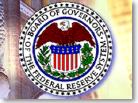|
Federal Reserve holds rates
|
 |
February 3, 1999: 3:58 p.m. ET
Fed leaves interest rates alone; economists see growth slowing
|
NEW YORK (CNNfn) - As expected, the Federal Reserve left interest rates unchanged Wednesday, a clear indication that decision makers in Washington believe the economy will continue to grow in a low-inflation environment.
The Fed held the federal funds overnight bank lending rate to 4.75 percent, the level it has been at since it was last cut by a quarter percentage point in November.
The discount rate on emergency loans from the central bank also was held to 4.50 percent.
For consumers, that means the cost of borrowing money for big ticket items, like new homes, will remain flat - at least until the Federal Open Market Committee meets again.
Fed decision makers are faced with an economy that has so far defied all predictions of a slowdown based on emerging-market turmoil and instead roared ahead at full speed.
While some sectors, notably manufacturing, have felt the effects of a downturn in U.S. export markets, free-spending U.S. consumers have taken up much of the slack and kept domestic demand growing strongly.
Those tracking the U.S. economy expect to see a slowdown later this year, but Fed officials have indicated they are in no rush to change rates until they see clear signs of that slowdown.
Meanwhile, inflation remains dormant, eliminating the need for higher rates that could prevent the economy from overheating.
The next FOMC meeting is scheduled for March 30.
The bond market meanwhile barely budged following the news, with the benchmark 30-year Treasury up 2/32 for a yield of 5.23 percent. Likewise for the stock market, which was broadly higher in afternoon trading.
Wayne Angell, chief economist at Bear Stearns and former Fed governor, said he believes the Fed maintained its neutral bias.
"The Fed may change its bias later this year, but I do not believe the Federal Reserve changed its bias at this meeting. I believe they kept a neutral directive."
That, he noted, will enable Fed Chairman Alan Greenspan to deliver his Humphrey Hawkins testimony later this month without "tipping the scales."
If the Fed shifted toward a tightening bias, Angell said, Greenspan may have had to spook the markets by "warning of warnings" to come.
"I don't think that took place," he said.
David Resler, managing director at Nomura Securities International and a former St. Louis Fed economist, added the reference to "ebbing inflation" in the FOMC minutes showed that the Fed adhered to the notion of real, inflation-adjusted rates.
Resler said the Fed's easing last fall only validated the drop in market rates that reflected a decline in inflation expectations tied to the collapse of commodities prices.
"Treasury rates had fallen a lot in August because the market sensed that, amid a severe global crisis exacerbated by Russia, commodities prices would remain depressed and corporations would have no pricing power," Resler said.
"It was a case where the market first acknowledged expectations of a lower inflation environment and the Fed endorsed this later," he said.
The 30-year Treasury bond yield fell from 5.70 percent in late July to 5.20 percent in late August. The bond yield subsequently set an intraday all-time low of 4.69 percent and a closing low of 4.71 percent on Oct. 5. 
-- from staff and wire reports
|
|
|
|
|
|
U.S. Federal Reserve
|
Note: Pages will open in a new browser window
External sites are not endorsed by CNNmoney
|
|
|
|
 |

|

